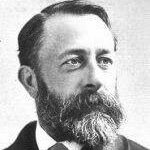ALBERT BIERSTADT
Albert Bierstadt was one of the most prominent and influential American landscape painters of the 19th century. Best known for his lavish, sweeping landscapes of the American West, Bierstadt joined several journeys of the Westward Expansion. With his enormous, detailed paintings of the Rocky Mountains and Sierra Nevada, he helped shape the visual identity of the American West in the United States and abroad.
Born near Dusseldorf, Germany, Bierstadt emigrated to New Bedford, Massachusetts with his family at age two. He returned to Germany in 1853 to study at the famed Royal Academy. Under the guidance of Andreas Aschenbach and Karl Friedman Lessing, Bierstadt learned the tenets of the “Dusseldorf School”, characterized by attention to minute detail, enhanced atmospheric effects and expansive compositions, all blending to heighten the romantic appeal of the landscape. In the spring of 1858, he made his New York debut at the annual exhibition at the National Academy of Design. Critics were dazzled by Bierstadt’s artistic abilities, and within weeks he was elected an honorary member of the academy. Bierstadt became internationally renowned for his beautiful paintings that not only rejoiced in the vastness of the western landscape, but celebrated in detail its flora, fauna and human inhabitants.
Collectors of Bierstadt’s work include: the Amon Carter Museum, Texas; the Art Institute of Chicago, Illinois; the Corcoran Gallery of Art, Washington D.C; the Metropolitan Museum of Art, New York and the Mississippi Museum of Art, Mississippi


